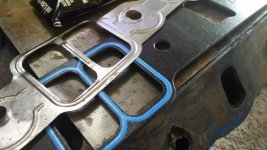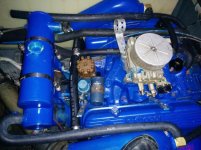Fish Stix
New member
Feel free to laugh - but I'd like hear some of my options
1 - it's an easy fix
2 - that's a massive screw up
3 - 360s are the way to go - buy two
After a truly extended maintenance period - I finally got the heads back on my port motor. The port motor is a FWC 318 with center risers and an unusual coolant route. The engines appear to be standard LA 318's but were marinized in the 1980s and confound many mechanics - I always wrote these mechanics off as non-chrysler guys.
As stated - I got the heads on using the Victor Reinz full gasket set. Since the heads were redone at a shop with their own parts - there were a few left over parts from the gasket kit.
The Seacock for coolant system is closed right now, but fresh water coolant system is full and not leaking (no change in a week), valve covers are on, distributor and spark plugs are the only task left.
Today I wanted to do a compression test to verify all was well. The engine turned over great, without spark plugs, and out came a blast of water from #2 that was really surprising! All the even side were spitting large drops of water with the starter engaged, and most likely the odd (port on port motor) were spitting water too.
The water level in the heat exchanger still hasn't changed - and the water ejected is not salt water. Oil still looks like oil and hasn't changed level.
Any idea where this water could be coming from? Any guesses? What part of the gasket set is/was critical to blocking water from traversing the mainfold / water inlet to the head?
The PO might have done some creative patching on the manifold - if that's broken internally, would water come out though the spark plug holes?
Thanks everyone one - feel free to chime in here.
Brooks
1 - it's an easy fix
2 - that's a massive screw up
3 - 360s are the way to go - buy two
After a truly extended maintenance period - I finally got the heads back on my port motor. The port motor is a FWC 318 with center risers and an unusual coolant route. The engines appear to be standard LA 318's but were marinized in the 1980s and confound many mechanics - I always wrote these mechanics off as non-chrysler guys.
As stated - I got the heads on using the Victor Reinz full gasket set. Since the heads were redone at a shop with their own parts - there were a few left over parts from the gasket kit.
The Seacock for coolant system is closed right now, but fresh water coolant system is full and not leaking (no change in a week), valve covers are on, distributor and spark plugs are the only task left.
Today I wanted to do a compression test to verify all was well. The engine turned over great, without spark plugs, and out came a blast of water from #2 that was really surprising! All the even side were spitting large drops of water with the starter engaged, and most likely the odd (port on port motor) were spitting water too.
The water level in the heat exchanger still hasn't changed - and the water ejected is not salt water. Oil still looks like oil and hasn't changed level.
Any idea where this water could be coming from? Any guesses? What part of the gasket set is/was critical to blocking water from traversing the mainfold / water inlet to the head?
The PO might have done some creative patching on the manifold - if that's broken internally, would water come out though the spark plug holes?
Thanks everyone one - feel free to chime in here.
Brooks



